Just like with traditional animation, Harmony uses layers to keep elements such as characters, backgrounds and props separate from each other, allowing you to animate them independently.
When you create a new scene, your scene will have a default layer named Drawing, in which you can immediately start drawing.

Layers can be selected and managed in the Timeline view. A scene can have as many layers as needed. When your scene has several layers, layers higher in the list appear over lower layers.

Types of Drawing Layers
Harmony supports two types of drawing layers, each with their own advantages and limitations:
- Vector Layers: Vector drawings are made of points and curves that compose the contours of the shapes of the artwork, along with the colour or textures these shapes are filled with. Hence, the artwork in vector layers can be scaled up and zoomed in without losing quality, unless they contain a texture.
- Bitmap Layers: Bitmap drawings are composed of a grid of pixels, which are small points that each have a single solid colour. Bitmap drawing tools allow you to lay on brush strokes onto a single flat canvas, and to tweak your artwork by the pixel if needed.
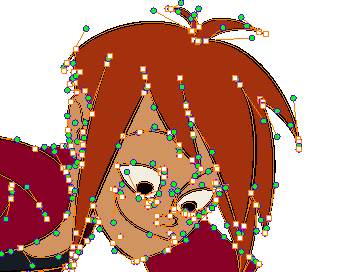
When drawing on a vector layer, each drawing stroke and pencil line is a separate object which can be manipulated individually. You can select single drawing strokes, then move them around and transform them, even if drawing strokes were applied over them. Additionally, because drawing strokes are made of points and curves, it is possible to edit their shape, making it easy to make corrections and changes to your artwork.
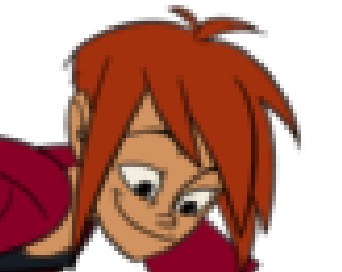
When you draw on a bitmap layer, each brush or pencil stroke is composited into the canvas, so it remains a single drawing that can only be painted or erased upon, but which does not allow you to tweak individual parts of it.
Bitmap artwork can only be scaled up or zoomed in on as much as their pixel density allows without losing picture quality. By default, bitmap artwork has a pixel density of 100%, which is only enough to display the artwork without zooming in on it or scaling it up, otherwise Harmony must generate new pixels within the artwork, which is liable to make it look blurry or pixelated.
Hence, you might want to set the required pixel density for your bitmap artwork, based on whether you'll need to zoom on it or scale it up, before you start drawing on a bitmap layer.
Art Layers
By default, each drawing layer actually has two art layers: The Line Art layer and the Colour Art layer. You can use these layers to keep the line art and colours in your drawings separate.
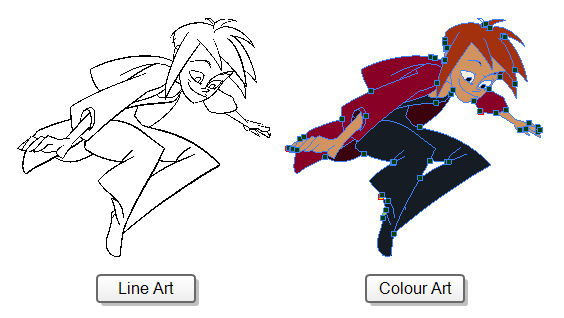
At the right of the Camera and Drawing view, you can control which art layer you are working on and whether only the current art layer or both art layers are displayed.
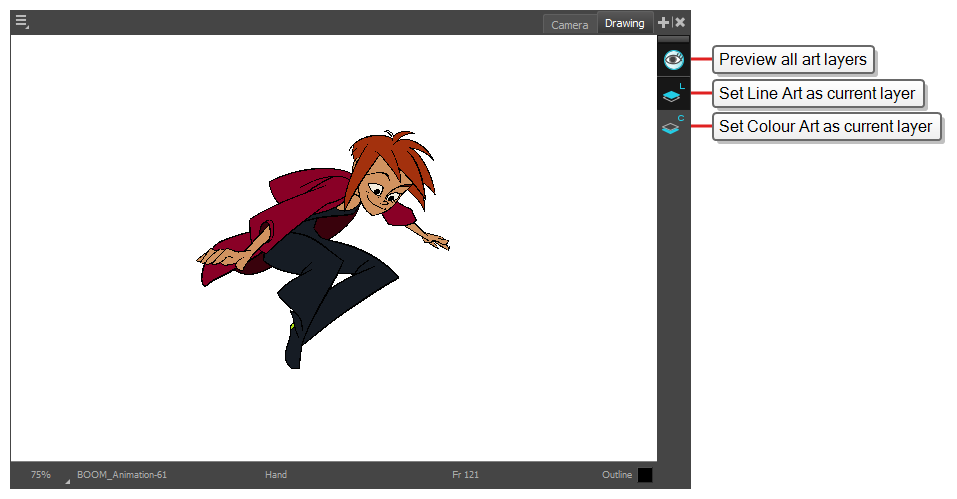
By default, the Line Art layer is selected. So if you start drawing right away, you will be drawing in your drawing layer's Line Art layer, unless you select the Colour Art layer first.
Using different art layers for your line art and colour art is entirely optional. If you like, you can use the Line Art layer for both your line art and colour art.
Renaming Layers
In a new scene, there is only one layer created by default, named Drawing. In traditional animation, it is common to name animation layers with single letters (A, B, C, etc.) and layout layers with acronyms (BG for background, OL for overlay, etc). So you can start off your scene by giving your first layer an appropriate name.
-
In the Timeline view, double-click on the name of the layer to rename.

A text-input field appears over the name.

-
Type in the new name for your layer and press Enter/Return.
The layer now has the new name.

Adding Layers
-
Do one of the following:
- In the Timeline view, click the
Add Drawing Layer button.
- In the top menu, select Insert > Drawing.
- Press Ctrl + R (Windows/Linux) or ⌘ + R (macOS).
The Add Drawing Layer dialog appears.
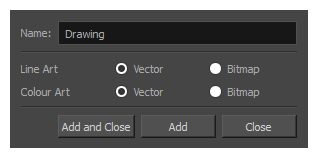
- In the Timeline view, click the
- In the Name field, type in the name for your new layer.
- Select whether you want the Line Art layer should be Vector or Bitmap.
- Select whether you want the Colour Art layer should be Vector or Bitmap.
-
Do one of the following:
- Click Add to create this layer, but leave the dialog open so you can create more layers.
- Click Add and Close to create this layer and close the dialog.
A new drawing layer is added to the Timeline view.

Deleting Layers
-
In the Timeline view, select the layers to delete.
 NOTE You can select several contiguous layers by holding down the Shift key, clicking on the first layer you want to select, then on the last layer you want to select. You can also select several layers by holding the Ctrl (Windows/Linux) or ⌘ (macOS) key and clicking on each layer you want to select.
NOTE You can select several contiguous layers by holding down the Shift key, clicking on the first layer you want to select, then on the last layer you want to select. You can also select several layers by holding the Ctrl (Windows/Linux) or ⌘ (macOS) key and clicking on each layer you want to select. - Do one of the following:
In the Timeline’s Layer toolbar, click the
Delete Layers button.

- Right-click on the selection and select Delete.
The selected layers are removed from the Timeline view.
Reordering Layers
-
In the Timeline view, select the layers to move.

-
Click and drag the selection, then do one of the following:
-
Drop the selection between two layers to move it between those layers. A cyan line will appear between the layers where the selection will be moved.

-
Drop the selection onto a layer to rig the selected layers as children over that layer.

-
Grouping Layers
Grouping layers allows you to keep your scene structure organized.
Additionally, you can put several layers inside a group, then add an effect on this group to apply that effect on all the layers inside the group.
-
In the Timeline view, select the elements you want to group.
 NOTE Any layer between the selected layers will be grouped with the selected layers.
NOTE Any layer between the selected layers will be grouped with the selected layers. - Do one of the following:
- Right-click on the highlighted layers and select Group Selection.
- Press Ctrl +Shift + G (Windows/Linux) or ⌘ + Shift + G (macOS).
A new Group layer is added to the Timeline view.

If you click on the
Expand Group button, you will find the grouped layers rigged as children of the group layer.

Hiding and Showing Layers
You can temporarily hide layers so that they do not clutter the Camera view while you are working on other layers.
-
In the Timeline view, left of the layer you want to hide, click on the
Disable Layer button.

The layer will become invisible in the Camera view.
-
When you want to unhide the layer, click on the
Enable Layer button to display it again.

Locking and Unlocking Layers
You can temporarily lock layers. Locked layers can still be edited in the Timeline or Xsheet view, but you cannot select them, draw them or manipulate them in the Camera view. This can be useful to avoid accidentally selecting or drawing over your backgrounds, overlays, props or characters you are not currently working on.
-
In the Timeline view, left of the layer you want to lock, click on the
Lock button.

The layer will become impossible to select or draw on in the Camera view. The name of the layer will appear in red in the Timeline view.
-
When you want to unlock the layer, click on the
Unlock Layer button to display it again.
